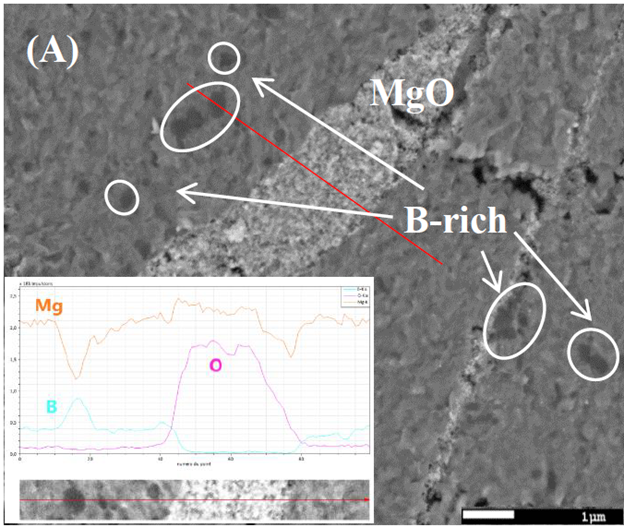Powders are converted into dense solids using the spark plasma sintering (SPS) method, which combines high pressure and pulsed electric current. In a recent study, a group of scientists created bulk magnesium diboride with a density that exceeded 95% of the material’s theoretical limit using SPS.

An SEM micrograph of MgB2, a superconductor, prepared at SIT, with different regions mapped. Caption: Scientists at SIT and University of Normandie developed bulk MgB2 with promising superconductivity. This picture shows unreacted magnesium oxide and boron in the matrix of MgB2, and the inset shows energy dispersive x-ray spectroscopy curves for boron, oxygen, and magnesium. Image Credit: Muralidhar Miryala fromSIT, Japan and Prof. Jacques G. Noudem from UN, France
In addition to having exceptional superconducting qualities, the highly dense material also demonstrated significant potential for use in superconducting motors, generators, and transportation systems. Superconductors are transforming many areas of industry, from superfast magnetic levitation trains and computer chips to MRI equipment and particle accelerators.
Below a specific critical point, a material’s ability to be superconductive makes it possible to transfer moving charges devoid of any resistance, suggesting that superconducting materials can carry electrical energy in a very efficient manner without loss in the form of heat.
Magnesium diboride, often known as MgB2, was first used in research about two decades ago.
Due to its low cost, superior superconducting properties, high critical current density, and trapped magnetic fields resulting from strong pinning of the vortices, MgB2 has experienced a resurgence in popularity.
The characteristics of the intermetallic MgB2 can also be modified. For instance, by reducing the grain size and increasing the number of grain boundaries, the critical current density values (Jc) of MgB2 can be improved. In ordinary layered superconductors, this adaptability is not seen.
However, the process of making MgB2 must be simplified to expand its uses. A group of researchers recently set out on a mission to accomplish this objective using a technique called spark plasma sintering (SPS) to create new bulk MgB2.
Their study was first published in the journal Nanomaterials on July 27th, 2022.
Spark plasma sintering (SPS) is a very interesting technique—it is a rapid consolidation method, where powder is turned into a dense solid. The heat source in this procedure is not external but is an electric current that flows across the die, causing the powder to sinter into a bulk material.
Muralidhar Miryala, Study Lead and Professor, Shibaura Institute of Technology
Prof. Miryala added, “The sintering kinetics can be understood and controlled better with SPS. Unlike other similar techniques, it allows grain growth control. What is more, it also has a shorter processing time!”
This unique technique was employed by Professors Miryala and Jacques G. Noudem (from the University of Normandie in France) to create large samples of MgB2. The final product’s density achieved 95% of the material’s theoretically expected density and exhibited exceptional superconducting qualities.
Prof. Pierre Bernstein and Yiteng Xing, a double degree Ph.D. candidate at SIT and the University of Normandie, were members of the study team.
The researchers filled a tungsten carbide (WC) mold with two powders, magnesium, and amorphous boron, and sintered them using SPS at various temperatures and pressures, ranging from 500 to 750 °C and 260 to 300 megapascal (MPa), before cooling the formed material.
About 100 minutes were spent processing the data in total. The researchers then used a variety of imaging and testing techniques to determine the density and structural characteristics of the prepared material.
Their research showed that the material has a high packing factor of 95% and a very high density of 2.46 g/cm3 (signifying that the atoms in the bulk material were situated very close to each other). Nano-grains and a significant number of grain boundaries were also visible.
Additionally, it did not display Mg-depleted phases, such as MgB4. The material had an exceptionally high Jc of up to 6.75 105 ampere/cm2 at roughly –253 °C, according to electromagnetic characterization. This implies that the team’s bulk MgB2 would function as a superconductor even at that high a current density.
Prof. Miryala commented, “Its Jc was quite remarkable for pure, undoped MgB2.”
The researchers looked further to learn how the material might have such great qualities. They concluded that the high density, excellent grain connectivity, lack of Mg-depleted phases, and strong pinning of vortices made possible by the presence of nano-grains and grain boundaries were all factors in the prepared MgB2’s superconducting properties.
This research offered a unique perspective for enhancing the qualities of superconducting materials like MgB2. This material can be employed in liquid hydrogen-cooled technology due to its high Jc. It is also developing as a strong contender for fuel, storage, and transportation systems based on liquid hydrogen.
“Global warming is one of the major threats humanity is facing today and shifting to a renewable energy economy is one of the most effective solutions to this problem. Given the material’s potential use in liquid hydrogen systems and its excellent structural and superconducting properties, our work is a positive step towards the realization of greener technology,” concluded Prof. Miryala.
Indeed, there is hope for a more eco-friendly and sustainable future!
Journal Reference:
Xing, Y., et al. (2022) High Critical Current Density of Nanostructured MgB2 Bulk Superconductor Densified by Spark Plasma Sintering. Nanomaterials. doi:10.3390/nano12152583.
Source: https://www.shibaura-it.ac.jp/en/